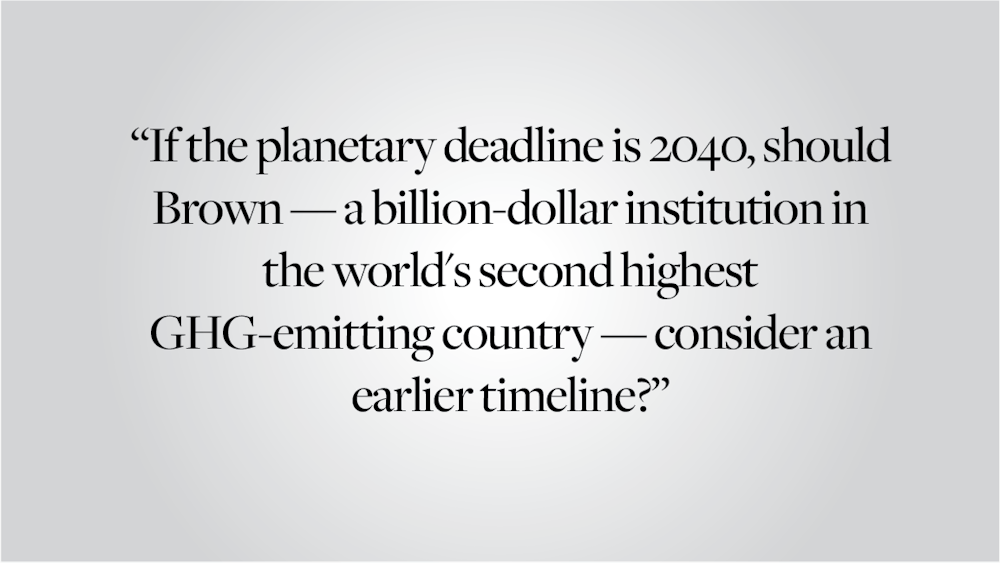When I toured colleges in 2020, I couldn't help but notice the signs around campus proudly declaring pledges to achieve "net-zero carbon emissions" by 2040 or 2050. While it was encouraging to witness such commitments, especially coming from Rio de Janeiro, Brazil, where such pledges were not yet being made, the timelines struck me as alarmingly distant. I imagined my future self living in a completely different world in 2040, and I found it hard to understand how any goal for that far out into the future could have implications for the high school junior that I was. More importantly, would these deadlines even be enough?
Scientific consensus unequivocally emphasizes the urgency of addressing anthropogenic greenhouse gas emissions to mitigate the catastrophic impacts of climate change. To avert an intense crisis, limiting global warming to 1.5°C is imperative. To do so, achieving global net zero carbon emissions by 2040 is critical. It is within this context that Brown, through its Sustainability Strategic Plan, pledged to achieve net-zero GHG emissions by 2040. The endeavor is estimated to cost around $200 million dollars and requires transitioning to 100% renewable electricity as well as converting Brown’s central heating system to low temperature hot water heated by renewable electricity. Setting such a goal, especially with remarkably detailed interim targets is commendable, but if the planetary deadline is 2040, should Brown — a billion-dollar institution in the world's second highest GHG-emitting country — consider an earlier timeline?? Shouldn’t we push for faster changes and help set a precedent for industries that are less likely to phase out on time?
The concept of "net-zero" entails achieving a balance between greenhouse gas emissions released into the atmosphere and those removed from it through various means, such as offsets or carbon capture and sequestration. While Brown ambitiously seeks to significantly reduce its emissions, the University still predicts a reliance on offsets to reach net-zero.
Brown's Sustainability Strategic Plan, acknowledges that the trajectory of life on Earth in this century hinges on "a dramatic shift in the way people go about their daily lives and the way organizations do business." The Office of Sustainability and Resilience is doing incredible work behind the scenes to work towards net-zero, like supporting the construction of a solar farm expected to offset 70% of annual electricity emissions, and the drilling of three, 1,000 feet deep test wells which will help design a plan for geothermal energy at Brown.
But, these acknowledgements and plans still fail to incentivize holistic change. Many of us still act in ways that are contrary to energy conservation, such as taking the elevator down a few flights of stairs and keeping windows open during the winter to help alleviate excess heat. Simple initiatives like Cornell's energy saving Energy Smackdown competition — which engages members of the university to rethink habits that are contrary to a more energy efficient future — could be a fun and valuable addition to our campus. In 2022, Cornell’s competition contributed to $160,000 in electricity savings and identified 14 energy reduction projects in campus buildings.
A 2021 report by S&P Global underscores the widespread inertia among companies when setting emission reduction targets, let alone committing to net-zero, as well as the lack of interim goals for those that did make commitments. Given the urgency of the climate crisis, there is already very little room for trial and error. If we wait until 2039 to "finish up" on getting to zero, the lack of a margin of error will be even more tragic, especially if there are too few institutions already at net-zero to set a precedent.
As a nonprofit institution with a $6.6 billion endowment and esteemed alumni and faculty, Brown is uniquely positioned to lead by example. Why then, should we not aspire to accelerate our timeline to 2030? Since plans are already in place to achieve a 75% reduction in GHG emissions by 2025, offsetting the remaining 25% appears not only feasible but necessary. While the University is spending $200 million on its net-zero goal, Brown also expects to save over "$80 million through 2040" as a result of power purchasing agreements (our solar farms will allow us to earn credits on our utility bills, per state law). Also, as referenced in the name of the Office of Sustainability and Resilience itself, these spendings are a part of making Brown more resilient to climate disasters. Given that, and the social benefits that could be achieved by an earlier net-zero deadline, the extra costs that the University might incur from pushing up the deadline are less significant.
While it is key to pressure corporations to make more ambitious climate targets as consumers and as voters, the reality of their profit-driven agendas makes it unlikely that they will be leading the charge. It is also not realistic to expect that other higher education institutions in the U.S. with much smaller endowments or such organizations in developing countries will have the ability to spend as much as Brown can in getting to net-zero. By expediting our journey to net-zero, Brown can serve as a model to other organizations.
As we adhere to international climate change recommendations, aiming for 2040 falls short of the urgency demanded by the crisis at hand. If we are to uphold our commitment to combating climate change, we must lead by example and invite others to join us on this expedited path to a carbon-neutral future.
Maria Claudia Gurjão ’26 can be reached at maria_claudia_gurjao_bonaparte@brown.edu. Please send responses to this column to letters@browndailyherald.com and other op-eds to opinions@browndailyherald.com.



